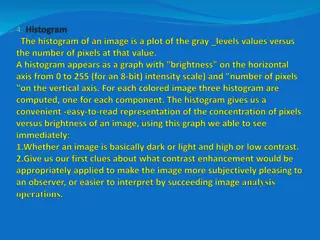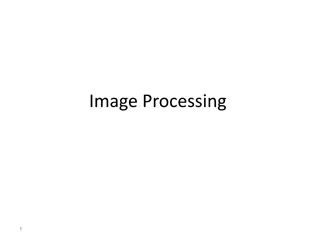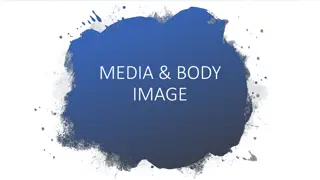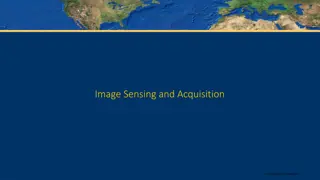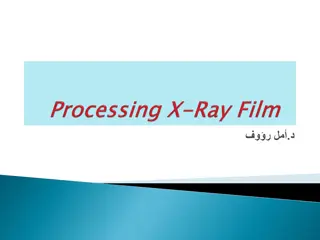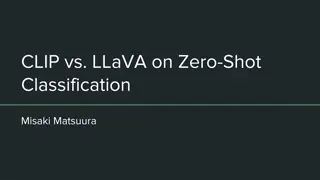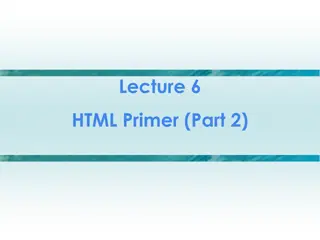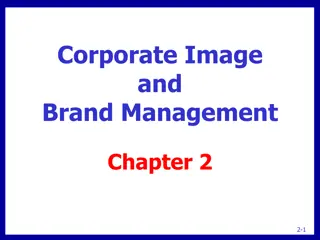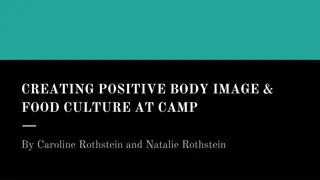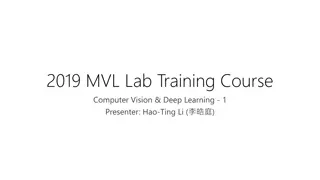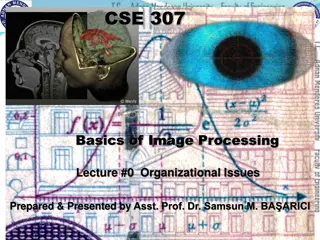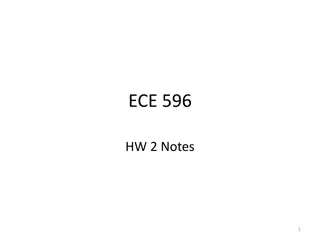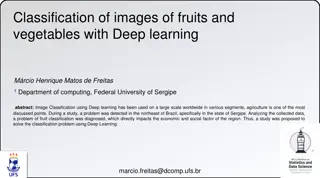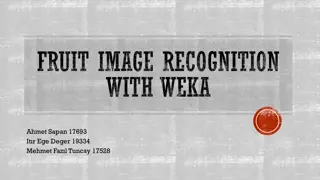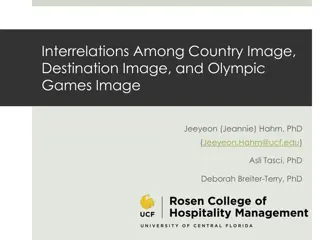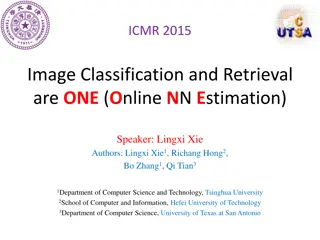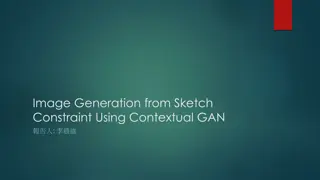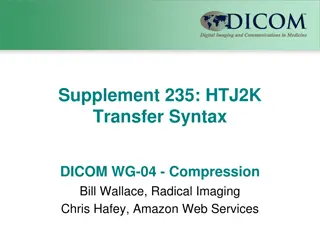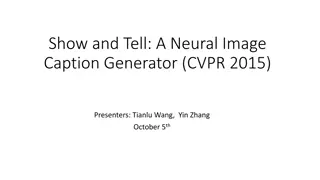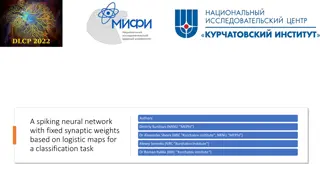Exploring AGImageAI: Enhancing Image Recognition with Artificial Intelligence
AGImageAI, developed by AlpineGate, is a cutting-edge image recognition software leveraging AI techniques to analyze various industries. AlpineGate, based in San Francisco, specializes in innovative solutions for image interpretation. Albert, the AI assistant, provides helpful information to users,
22 views • 21 slides
Understanding Classification Keys for Identifying and Sorting Things
A classification key is a tool with questions and answers, resembling a flow chart, to identify or categorize things. It helps in unlocking the identification of objects or living things. Explore examples like the Liquorice Allsorts Challenge and Minibeast Classification Key. Also, learn how to crea
1 views • 6 slides
Basics of Fingerprinting Classification and Cataloguing
Fingerprint classification is crucial in establishing a protocol for search, filing, and comparison purposes. It provides an orderly method to transition from general to specific details. Explore the Henry Classification system and the NCIC Classification, and understand why classification is pivota
5 views • 18 slides
Understanding Image Histograms and Modifications
Image histograms provide valuable insights into the nature of images, with characteristics like width, skewness, and peaks revealing information about contrast, brightness, and objects within. Different types of histograms indicate varying image attributes, aiding in tasks like threshold parameter s
1 views • 13 slides
Understanding ROC Curves in Multiclass Classification
ROC curves are extended to multiclass classification to evaluate the performance of models in scenarios such as binary, multiclass, and multilabel classifications. Different metrics such as True Positive Rate (TPR), False Positive Rate (FPR), macro, weighted, and micro averages are used to analyze t
3 views • 8 slides
Understanding Computer Vision and Image Processing
Introduction to the fields of computer vision and image processing, exploring their differences and how they intertwine. Computer vision focuses on processing images for computer use, while image processing enhances images for human consumption. Topics include image analysis, restoration, enhancemen
1 views • 100 slides
Understanding the Influence of Media on Body Image Perception
The media plays a significant role in shaping perceptions of body image, influencing how individuals view themselves and others. This article explores the impact of media portrayal on body image perceptions in both men and women, discussing the positive and negative influences of media representatio
3 views • 9 slides
Understanding Classification in Data Analysis
Classification is a key form of data analysis that involves building models to categorize data into specific classes. This process, which includes learning and prediction steps, is crucial for tasks like fraud detection, marketing, and medical diagnosis. Classification helps in making informed decis
2 views • 72 slides
AI Projects at WIPO: Text Classification Innovations
WIPO is applying artificial intelligence to enhance text classification in international patent and trademark systems. The projects involve automatic text categorization in the International Patent Classification and Nice classification for trademarks using neural networks. Challenges such as the av
2 views • 10 slides
Foundations of Image Sensing and Acquisition in GIS
Understanding the process of image acquisition is crucial for digital image processing in GIS. It involves using physical devices sensitive to different energy bands to convert images into digital form through digitizers. Various methods such as single sensors, sensor strips, and sensor arrays are u
2 views • 16 slides
Understanding X-Ray Film Processing Techniques
When a beam of photons exposes an X-ray film, it chemically alters the silver halide crystals, creating a latent image. Film processing involves developer, fixer, and a series of steps to convert the latent image into a visible radiographic image. The developer reduces silver ions in exposed crystal
0 views • 26 slides
Understanding Pixel Relationships in Image Processing
Exploring the fundamental concepts of pixel relationships in image processing, including 4-neighbors, 8-neighbors, adjacency criteria, and their significance in digital image analysis. The content covers the basics of pixel connectivity and neighbor sets, offering insights into how pixels interact a
1 views • 67 slides
Deep Image Enhancement Project Progress Report
The Deep Screen Image Crop and Enhance project, led by Aaron Ott and Amir Mazaheri, focuses on improving image quality through a multi-step approach involving image detection, cropping, and enhancement. The project utilizes advanced techniques like super-resolution networks and deep residual network
0 views • 10 slides
Comparing CLIP vs. LLaVA on Zero-Shot Classification by Misaki Matsuura
In this study by Misaki Matsuura, the effectiveness of CLIP (contrastive language-image pre-training) and LLaVA (large language-and-vision assistant) on zero-shot classification is explored. CLIP, with 63 million parameters, retrieves textual labels based on internet image-text pairs. On the other h
0 views • 6 slides
Understanding Taxonomy and Scientific Classification
Explore the world of taxonomy and scientific classification, from the discipline of classifying organisms to assigning scientific names using binomial nomenclature. Learn the importance of italicizing scientific names, distinguish between species, and understand Linnaeus's system of classification.
0 views • 19 slides
Overview of Fingerprint Classification and Cataloguing Methods
Explore the basics of fingerprint classification, including Henry Classification and NCIC Classification systems. Learn about the importance of classification in establishing protocols for searching and comparison. Discover the components of Henry Classification, such as primary, secondary, sub-seco
1 views • 21 slides
Understanding BioStatistics: Classification of Data and Tabulation
BioStatistics involves the classification of data into groups based on common characteristics, allowing for analysis and inference. Classification organizes data into sequences, while tabulation systematically arranges data for easy comparison and analysis. This process helps simplify complex data,
0 views • 12 slides
Understanding HTML Image Tags and Attributes
Delve into the world of HTML image tags and attributes with this detailed overview. Learn how to display images, make them clickable links, adjust image sizes, and utilize various attributes for styling and alignment. Discover the differences between image formats such as GIF and JPEG, and master th
1 views • 32 slides
Introduction to Decision Tree Classification Techniques
Decision tree learning is a fundamental classification method involving a 3-step process: model construction, evaluation, and use. This method uses a flow-chart-like tree structure to classify instances based on attribute tests and outcomes to determine class labels. Various classification methods,
5 views • 20 slides
Corporate Image and Brand Management Overview
This chapter delves into the management of corporate image and brands, covering topics such as developing brand names and logos, the importance of packaging, brand positioning strategies, and the components of corporate image. It explores perspectives from both consumers and companies, highlights th
0 views • 32 slides
Exploring Positive Body Image and Food Culture at Camp
Explore themes surrounding body image and food culture at camp, understanding how these impact campers and staff. Learn to make positive shifts in camp culture, addressing disordered eating and emotional eating. Discover the intersection of food and body image, challenges faced, promoting body posit
0 views • 15 slides
Athletes' Image Repair Strategies: A Study on Media Accounts Following Violations
Investigating how professional athletes utilize personal accounts as an image repair strategy after facing violations. The study delves into trends, variables affecting strategies, and the importance of public image for athletes. Key theoretical foundations include Image Restoration Theory and Accou
0 views • 33 slides
Understanding Image Classification in Computer Vision
Image Classification is a crucial task in Computer Vision where images are assigned single or multiple labels based on their content. The process involves training a classifier on a labeled dataset, evaluating its predictions, and using algorithms like Nearest Neighbor Classifier. Challenges and the
0 views • 16 slides
Multimodal Semantic Indexing for Image Retrieval at IIIT Hyderabad
This research delves into multimodal semantic indexing methods for image retrieval, focusing on extending Latent Semantic Indexing (LSI) and probabilistic LSI to a multi-modal setting. Contributions include the refinement of graph models and partitioning algorithms to enhance image retrieval from tr
1 views • 28 slides
Basics of Digital Image Processing: Course Overview and Objectives
This course on digital image processing covers fundamental concepts, tools, and algorithms used in analyzing and enhancing images. Students will gain knowledge on spatial and frequency domain analysis, algorithm implementation, image reconstruction, and more. The main objective is to provide a stron
0 views • 15 slides
Understanding K-means Clustering for Image Segmentation
Dive into the world of K-means clustering for pixel-wise image segmentation in the RGB color space. Learn the steps involved, from making copies of the original image to initializing cluster centers and finding the closest cluster for each pixel based on color distances. Explore different seeding me
0 views • 21 slides
Classification of Fruits and Vegetables with Deep Learning in Sergipe
Image classification using Deep Learning was employed to tackle the issue of fruit misclassification impacting agriculture in Sergipe, Brazil. The study aimed to understand the causes of fruit loss, train neural networks for sorting, and evaluate classification accuracy to address production challen
0 views • 4 slides
Hierarchical Semi-Supervised Classification with Incomplete Class Hierarchies
This research explores the challenges and solutions in semi-supervised entity classification within incomplete class hierarchies. It addresses issues related to food, animals, vegetables, mammals, reptiles, and fruits, presenting an optimized divide-and-conquer strategy. The goal is to achieve semi-
0 views • 18 slides
Understanding Classification in Data Mining
Classification in data mining involves assigning objects to predefined classes based on a training dataset with known class memberships. It is a supervised learning task where a model is learned to map attribute sets to class labels for accurate classification of unseen data. The process involves tr
0 views • 26 slides
Fruit Image Recognition with Weka: Methods & Results
Fruit image recognition project with Weka involved testing various classification methods using deep-learning techniques for feature extraction and achieving accurate results. Methods included ZeroR, J48 decision tree, and feature manipulation to improve classification accuracy levels. Results showe
0 views • 12 slides
Interrelations Among Country, Destination, and Olympic Games Images
This research explores the interconnectedness of country image, destination image, and Olympic Games image to identify beneficiaries and benefactors in these complex relationships. It aims to understand how these images influence each other and future visit intentions. The study utilizes a conceptua
0 views • 10 slides
Unified Model for Image Classification and Retrieval at ICMR 2015
In this study presented at ICMR 2015, the focus is on a unified model that combines image classification and retrieval. The goal is to address differences between the two tasks and explore the benefits of a unified approach. Researchers Lingxi Xie, Richang Hong, Bo Zhang, and Qi Tian delve into the
0 views • 34 slides
Contextual GAN for Image Generation from Sketch Constraint
Utilizing contextual GAN, this project aims to automatically generate photographic images from hand-sketched objects. It addresses the challenge of aligning output with free-hand sketches while offering advantages like a unified network for sketch-image understanding. The process involves posing ima
0 views • 21 slides
Revolutionizing Image Compression with HTJ2K Transfer Syntax
Revolutionize image compression with HTJ2K Transfer Syntax, a groundbreaking technology that addresses existing challenges in compression standards like JPEG 2000. HTJ2K offers improved decode and encode speeds, strong open-source support, and scalable resolution access. Explore how HTJ2K is reshapi
0 views • 6 slides
Research Progress and Results in Image Dataset Analysis
Research progress and results in image dataset analysis including experiment outcomes, discussion on model performance, dataset analysis, and model training. The study covers topics such as analysis of kiwi leaf trips and spots, model ensemble techniques, teacher-student learning, and the effectiven
0 views • 12 slides
Deep Learning for Low-Resolution Hyperspectral Satellite Image Classification
Dr. E. S. Gopi and Dr. S. Deivalakshmi propose a project at the Indian Institute of Remote Sensing to use Generative Adversarial Networks (GAN) for converting low-resolution hyperspectral images into high-resolution ones and developing a classifier for pixel-wise classification. The aim is to achiev
0 views • 25 slides
Neural Image Caption Generation: Show and Tell with NIC Model Architecture
This presentation delves into the intricacies of Neural Image Captioning, focusing on a model known as Neural Image Caption (NIC). The NIC's primary goal is to automatically generate descriptive English sentences for images. Leveraging the Encoder-Decoder structure, the NIC uses a deep CNN as the en
0 views • 13 slides
Robust High-Dimensional Classification Approaches for Limited Data Challenges
In the realm of high-dimensional classification with scarce positive examples, challenges like imbalanced data distribution and limited data availability can hinder traditional classification methods. This study explores innovative strategies such as robust covariances and smoothed kernel distributi
0 views • 10 slides
Spiking Neural Network with Fixed Synaptic Weights for Classification
This study presents a spiking neural network with fixed synaptic weights based on logistic maps for a classification task. The model incorporates a leaky integrate-and-fire neuron model and explores the use of logistic maps in synaptic weight initialization. The work aims to investigate the effectiv
0 views • 8 slides
Understanding Digital Image Processing Fundamentals
This content provides insights into the essential aspects of digital image processing, focusing on elements of visual perception, the structure of the eye, image formation, brightness adaptation, and discrimination. Explore how the human visual system, akin to a camera, processes visual information
1 views • 8 slides



